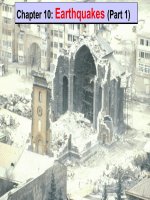Lecture 20 earthquakes
Bạn đang xem bản rút gọn của tài liệu. Xem và tải ngay bản đầy đủ của tài liệu tại đây (3.13 MB, 29 trang )
Chapter 10: Earthquakes (Part 1)
Class Announcements
Papago Park extra credit
field trip (worth 20 points).
Options:
*Mon., April 14: 4-5PM
Wed., April 16: 10-11AM or 4-5 PM
Thurs., April 17: 10-11AM or 2-3 PM
* Added
Announcements
- Papago Park Fieldtrip
Can now sign up at website.
Note: Extra trip option added:
Mon. April 14, 4-5 PM.
See maps and directions.
Reminders in class week
before trips.
- Quiz this Friday
Volcanoes (Chap. 9)
Earthquakes (Chap. 10)
Earth’s Interior (Inter. C)
Announcements
- Papago Park Fieldtrip
Sign up at website.
Note: Extra trip option added:
Mon. April 14, 4-5 PM.
See maps and directions.
Reminders in class week
before trips.
- Quiz this Friday
Volcanoes (Chap. 9)
Earthquakes (Chap. 10)
Earth’s Interior (Inter. C)
Student Presentation
Coastal Rock Formations
Villasinee Kongsomboonvech
Today’s Lecture
- Introduction to earthquakes
What is an Earthquake?
Types of faults.
Where do Earthquakes occur?
Plate tectonic context
- Types of earthquake waves
Body waves
P-waves
S-waves
Surface waves
Rayleigh waves
Love waves
Today’s Lecture
- Introduction to earthquakes
Where do Earthquakes occur?
Plate tectonic context
- Types of earthquake waves
Body waves
P-waves
S-waves
Surface waves
Rayleigh waves
Love waves
Definitions
Fault - Fracture in the Earth where slip occurs
Earthquake - Energy released by slip along a fault
Earthquake focus - Location of initial break
What is an earthquake?
Elastic rebound theory
- Describes the origin of earthquakes.
- Blocks of rock try to move in opposing
directions along a fault.
- Friction prevents slippage and stress builds.
- Stress is stored in rocks as elastic energy.
- When strength of rock exceeded, rock
ruptures and slips, releasing the
stored elastic energy.
Build up of stress.
Elastic deformation.
Strength of rock exceeded
Rock ruptures with slip along fault.
Elastic energy released.
Fig. 10.01
W. W. Norton
Fig. 10.10
W. W. Norton
Stress builds up along faults because blocks
are locked together by friction along fault plane.
Fig. 10.09
W. W. Norton
What is an earthquake?
fault
Definitions
Stress - Force applied to a material.
Strain - Deformation of a material under stress.
Elastic strain - When stress released, material
returns to original shape.
Ductile (plastic) strain - When stress released,
material does not return
to original shape.
Brittle behavior - Rupture of materials occurs when
elastic limit exceeded.
Under elastic strain, when
stress is released, deformed
objects assume their
original shape.
Fig. 10.08
W. W. Norton
Fig. 10.12
W. W. Norton
Earthquake!
p.276-277b
Original artwork by Gary Hincks
Elastic energy released travels as
a series of spherical waves
through the Earth radiating
away from the break (focus).
Fig. 10.37
W. W. Norton
Fig. 10.11
W. W. Norton
More definitions:
Fault plane: Surface of slippage.
Earthquake focus: Point of initial breakage.
Epicenter: Site at surface immediately above focus.
W. W. Norton
Types of Faults
Faults With Vertical Slip
Normal faults: Block above fault plane
has dropped “down”.
Fault scarp: cliff produced by vertical slip on fault.
Vertical Slip = Normal Faults
Up
Down
Lateral (Strike) Slip Faults
Turkey
Aug 1999
M 7.4
Fig. 10.05









